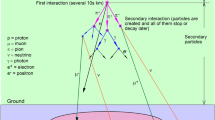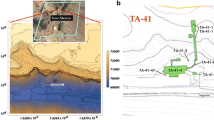Abstract
In CO2 geological sequestration, a combination of monitoring techniques needs to be in place to timely detect possible CO2 leakage from a primary storage along unanticipated pathways to shallower formations. This research aims to methodologically investigate the feasibility of a novel radiographic technique, i.e. cosmic-ray muon radiography, as a complementary continuous monitoring method. As an example, this method was tested on a geological model to monitor CO2 leakage into upper freshwater aquifers. The effectiveness of the method was preliminarily established by high-fidelity simulations, including the sensitivity for responding to CO2 leakage and the spatial resolution that can be achieved by the method. The simulation results indicate an increase of penetrating flux of the cosmic-ray muons with the increase of CO2 leakage in the monitored aquifers. The sensitivity tends to be higher in monitoring leakage taking place in shallower depths. At depths of about 200 m, the detectable CO2 can be as low as 3 % measured in volume fraction with a relatively high confidence level. The spatial resolution can be achieved within a range from 10 to 20 m for measurements at depths of no more than 520 m, demonstrating the effectiveness of the method.








Similar content being viewed by others
References
Aglietta M, Alpat B, Alyea E, Antonioli P, Badino G, Bari G, Basile M, Berezinsky V, Bersani F, Bertaina M (1998) Muon “depth-intensity” relation measured by the LVD underground experiment and cosmic-ray muon spectrum at sea level. Phys Rev D 58:092005
Agostinelli S, Allison J, Amako KA, Apostolakis J, Araujo H, Arce P, Asai M, Axen D, Banerjee S, Barrand G (2003) GEANT4—a simulation toolkit. Nucl Instrum Methods Phys Res, Sect A Accel Spectrom Detect Assoc Equip 506:250–303
Amsler C, Doser M, Antonelli M, Asner D, Babu K, Baer H, Band H, Barnett R, Bergren E, Beringer J (2008) Review of particle physics. Phys Lett B 667:1–6
Anderson S, Newell R (2004) Prospects for carbon capture and storage technologies. Annu Rev Environ Resour 29:109–142
Arts R, Eiken O, Chadwick A, Zweigel P, van der Meer L, Zinszner B (2004) Monitoring of CO2 injected at Sleipner using time-lapse seismic data. Energy 29:1383–1392
Birkholzer J, Zhou Q, Tsang C (2009) Large-scale impact of CO2 storage in deep saline aquifers: a sensitivity study on pressure response in stratified systems. Int J Greenh Gas Control 3:181–194
Borozdin KN, Hogan GE, Morris C, Priedhorsky WC, Saunders A, Schultz LJ, Teasdale ME (2003) Surveillance: radiographic imaging with cosmic-ray muons. Nature 422:277
Bugaev EV, Misaki A, Naumov VA, Sinegovskaya T, Sinegovsky S, Takahashi N (1998) Atmospheric muon flux at sea level, underground, and underwater. Phys Rev D 58:054001
Burkhard J, Fakhry A, Girgis A, Goneid A, Moussa AH, Mohammed-Sharkawi LY (1970) Search for hidden chambers in the pyramids. Science 167:832–839
Chadwick RA, Arts R, Bentham M, Eiken O, Holloway S, Kirby GA, Pearce JM, Williamson JP, Zweigel P (2009) Review of monitoring issues and technologies associated with the long-term underground storage of carbon dioxide. In: Evans DJ, Chadwick RA (eds) Underground gas storage: worldwide experiences and future development in the UK and Europe, 313th edn. Geological Society, Special Publications, London, pp 257–275
Gaisser TK (1990) Cosmic rays and particle physics. Cambridge University Press, Cambridge
Groom DE, Mokhov NV, Striganov SI (2001) Muon stopping power and range tables 10 MeV–100 TeV. At Data Nucl Data Tables 78:183–356
Hepple RP, Benson SM (2004) Geologic storage of carbon dioxide as a climate change mitigation strategy: performance requirements and the implications of surface seepage. Environ Geol 47:576–585
Jenneson P (2004) Large vessel imaging using cosmic-ray muons. Nucl Instrum Methods Phys Res Sect A Accel Spectrom Detect Assoc Equip 525:346–351
Jiang X (2011) A review of physical modelling and numerical simulation of long-term geological storage of CO2. Appl Energy 88:3557–3566
Jiang X, Akber Hassan WA, Gluyas J (2013) Modelling and monitoring of geological carbon storage: a perspective on cross-validation. Appl Energy 112:784–792
Kak A, Slaney M (1999) Algorithms for reconstruction with nondiffracting source. Principles of computerized tomographic imaging. IEEE Press, New York
Kudryavtsev VA, Spooner NC, Gluyas JG, Fung C, Coleman ML (2012) Monitoring subsurface CO2 emplacement and security of storage using muon tomography. Int J Greenh Gas Control 11:21–24
Lemmon E, McLinden M, Friend D, Linstrom P, Mallard W (2010) NIST chemistry webbook, Nist standard reference database number 69. Thermophysical Properties of Fluid Systems. National Institute of Standards and Technology, Gaithersburg
Lesparre N, Gibert D, Marteau J, Déclais Y, Carbone D, Galichet E (2010) Geophysical muon imaging: feasibility and limits. Geophys J Int 183:1348–1361
Leung DYC, Caramanna G, Maroto-Valer MM (2014) An overview of current status of carbon dioxide capture and storage technologies. Renew Sustain Energy Rev 39:426–443
Marteau J, Gibert D, Lesparre N, Nicollin F, Noli P, Giacoppo F (2012) Muons tomography applied to geosciences and volcanology. Nucl Instrum Methods Phys Res Sect A Accel Spectrom Detect Assoc Equip 695:23–28
Mazess RB, Barden HS, Bisek JP, Hanson J (1990) Dual-energy x-ray absorptiometry for total-body and regional bone-mineral and soft-tissue composition. Am J Clin Nutr 51:1106–1112
Nagamine K, Iwasaki M, Shimomura K, Ishida K (1995) Method of probing inner-structure of geophysical substance with the horizontal cosmic-ray muons and possible application to volcanic eruption prediction. Nucl Instrum Methods Phys Res, Sect A 356:585–595
Nakamura K, PD Group (2010) Review of particle physics. J Phys G Nucl Part Phys 37:075021
Nicot JP (2008) Evaluation of large-scale CO2 storage on fresh-water sections of aquifers: an example from the Texas Gulf Coast Basin. Int J Greenh Gas Control 2:582–593
Olive K A (2014 and 2015 update) Particle Data Group. Chin Phys C, 38, 090001
Park YC, Huh DG, Park CH (2013) A sensitivity study of pressure monitoring to detect fluid leakage from geological co2 storage site. Energy Procedia 37:4207–4214
Petersilka M, Bruder H, Krauss B, Stierstorfer K, Flohr TG (2008) Technical principles of dual source CT. Eur J Radiol 68:362–368
Priedhorsky WC, Borozdin KN, Hogan GE, Morris C, Saunders A, Schultz LJ, Teasdale ME (2003) Detection of high-Z objects using multiple scattering of cosmic ray muons. Rev Sci Instrum 74:4294–4297
Robinson M, Kudryavtsev V, Lüscher R, McMillan J, Lightfoot P, Spooner N, Smith N, Liubarsky I (2003) Measurements of muon flux at 1070 m vertical depth in the Boulby underground laboratory. Nucl Instrum Methods Phys Res Sect A Accel Spectrom Detect Assoc Equip 511:347–353
Schultz L J (2003) Cosmic ray muon radiography (Doctoral dissertation). Portland State University
Socolow RH (2005) Can we bury global warming? Sci Am 293:49–55
Tanaka HKM (2014) Particle geophysics. Annu Rev Earth Planet Sci 42:535–549
Tanaka H K, Uchida T, Tanaka M, Shinohara H, Taira H (2009) Cosmic-ray muon imaging of magma in a conduit: degassing process of Satsuma-Iwojima Volcano, Japan. Geophys Res Lett 36:L01304
Tanaka H, Nagamine K, Kawamura N, Nakamura SN, Ishida K, Shimomura K (2003) Development of a two-fold segmented detection system for near horizontally cosmic-ray muons to probe the internal structure of a volcano. Nucl Instrum Methods Phys Res Sect A Accel Spectrom Detect Assoc Equip 507:657–669
Tanaka H, Nagamine K, Nakamura S, Ishida K (2005) Radiographic measurements of the internal structure of Mt. West Iwate with near-horizontal cosmic-ray muons and future developments. Nucl Instrum Methods Phys Res Sect A 555:164–172
Tanaka HKM, Nakano T, Takahashi S, Yoshida J, Niwa K (2007) Development of an emulsion imaging system for cosmic-ray muon radiography to explore the internal structure of a volcano, Mt. Asama. Nucl Instrum Methods Phys Res Sect A 575:489–497
Tanaka HK, Taira H, Uchida T, Tanaka M, Takeo M, Ohminato T, Aoki Y, Nishitama R, Shoji D, Tsuiji H (2010a) Three-dimensional computational axial tomography scan of a volcano with cosmic ray muon radiography. J Geophys Res Solid Earth 1978–2012:115
Tanaka HKM, Uchida T, Tanaka M, Shinohara H, Taira H (2010b) Development of a portable assembly-type cosmic-ray muon module for measuring the density structure of a column of magma. Earth Planets Space 62:119–129
Wiese B, Zimmer M, Nowak M, Pellizzari L, Pilz P (2013) Well-based hydraulic and geochemical monitoring of the above zone of the CO2 reservoir at Ketzin, Germany. Environ Earth Sci 70:3709–3726
Yamamoto H, Zhang K, Karasaki K, Marui A, Uehara H, Nishikawa N (2009) Numerical investigation concerning the impact of CO2 geologic storage on regional groundwater flow. Int J Greenh Gas Control 3:586–599
Yamashina Y, Yamashina T, Taira H, Tanaka HKM (2010) Development of a cost-effective plastic scintillator for cosmic-ray muon radiography of a volcano. Earth Planets Space 62:173–177
Young HD (1962) Statistical treatment of experimental data. McGraw-Hill Inc, New York
Author information
Authors and Affiliations
Corresponding author
Rights and permissions
About this article
Cite this article
Zhong, J., Jiang, X. A study of using cosmic-ray muon radiography to detect CO2 leakage from a primary storage into geological formations. Environ Earth Sci 75, 912 (2016). https://doi.org/10.1007/s12665-016-5711-5
Received:
Accepted:
Published:
DOI: https://doi.org/10.1007/s12665-016-5711-5




